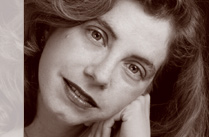 |
 |
 |
|
|
. . . . Sign up for
Find Mary
Sharratt
Find Daughters
of
|
Set in the Twin Cities during World War I, Summit Avenue (Coffee House Press, $14.95) is a fictional journal of Kathrin, a 22-year-old German immigrant who describes herself as a crone who lives in the woods like a "witch in a fairy tale." "You can read the book as an immigrant story, a woman's quest novel, a love story, or an archetypal fable," says author Mary Sharratt, a Minnesota native who now lives in California. "I wanted it to be a bit of a hologram, so that you can look down and see its different layers." Kathrin begins her American life at the Pillsbury mill sewing flour bags by day and learning English by night. She finds refuge from the hard mill life in an antiquarian book store, and she is befriended by the immigrant owners Jan Jelinek and his nephew, John. One night, Violet Waverly, a wealthy and enigmatic widow who lives on Summit Avenue, comes into the bookstore and launches the young maiden on a trek of self-discovery. Fans of Clarissa Pinkola Estes' Women Who Run with the Wolves, the popular Jungian analysis of female images in folk tales, will appreciate Sharratt's weaving of the Baba Yaga and Vasalisa initiation story throughout the book. Instead of being sent like Vasalisa into the forest by her stepmother to bring back fire from Baba Yaga's castle, Kathrin has been sent by her favorite uncle to America after her mother dies to find a better life. "Violet is the sorceress and Kathrin is the girl with the fire that both illuminates and terrifies her," Sharratt explains. "First she runs away, but then she comes into her power, returning to the house in the forest." The ending has raised questions from many readers. "I intended it to be a very positive, hopeful ending, but the different ways that readers have responded to it has been a big surprise," she says. "People have asked for a sequel, and I probably will do one because the ending seems to have raised so many questions. The sequel I'm considering will be from Kathrin's daughter's perspective." Sharratt is working on a second novel with roots in Minnesota. Set in the 1920s, it tells the story of how three strong-willed women rebel against the structure of their small town and end up changing the community. Sharratt grew up in Bloomington, but lived in Germany for many years. "I didn't choose writing. It kind of chose me," she says. "I was living in a different country and I didn't have a television set. I'd run out of English books to read because they're very expensive, so for relaxation in the evenings I started writing. And over a very long time, I ended up writing my own book." Discussion Questions: - How would you classify this book? How would you describe it to a friend? - What was your reaction to the book's fairy tale metaphors? - The ending can be interpreted in different ways. Were you hopeful for Kathrin and her child at the end, or were you discouraged about their future? - John and Kathrin were two young immigrants with entirely different approaches to the American Dream. Putting yourself in their shoes, which path would you have chosen and why? - Violet's character and choices can be viewed from many perspectives. How do you feel about the way she treated Kathrin? - What would you have done if you were in Kathrin's circumstances in the early 1900s--about Violet, about John, and about the baby? Originally published in Minnesota Monthly -- January 2002 |
||||

